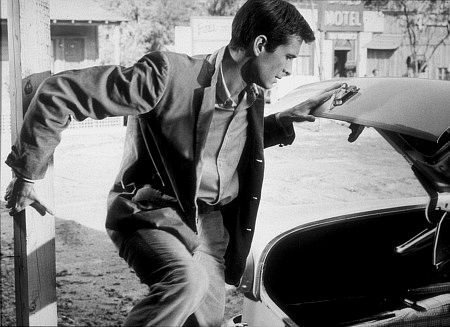Alfred Hitchcock’s 1960 film Psycho is psychological horror story which shocked audiences in 1960 and even nowadays for those not familiar with the story continues to offer shock and suspense. The death of the leading lady within the first hour was and still is a surprise to the audience and leaves them wondering where the story is going to go.
The film is 109 minutes long, but he offs his heroine, the glamorous miscreant with whom he's made us identify, after just 47. In 1960, this generated, by all accounts, an unprecedented sense of careering into uncharted and terrifying territory: what the hell would happen next? Even now, it's distinctly unnerving. (Monahan 2015)

fig.1
The story continues to provide suspense through its twists and turns so as an audience you never are sure where it is going, as Norman Bates cleans the motel room after he has murdered Marion you are expecting for him to find the money she stole and hid in the paper, but it simply gets thrown in the boot of the car with Marion’s body which is then pushed in to a swamp

fig.2
"Psycho" continues to work as a frightening, insinuating thriller. That's largely because of Hitchcock's artistry in two areas that are not as obvious: The setup of the Marion Crane story, and the relationship between Marion and Norman. (Ebert 1998)
Alfred Hitchcock manipulates his audience through the use of the camera work and musical accompaniments, the black and white photography works very well and provides the film with a dark mood, he could have used colour but chose not to.
The black-and-white photography is perfect for the film's tone and mood - the starkness of color would have blurred the nightmarish quality. It wasn't a message that stirred the audiences, nor was it a great performance...they were aroused by pure film. (1960)
Bibliography:
Websites:
Mark Monahan
30 Jun 2015
Roger Ebert
December 6, 1998
James Berardinelli
Images
fig.2 http://images2.fanpop.com/images/photos/5500000/Anthony-Perkins-in-Psycho-psycho-5531581-450-327.jpg

:)
ReplyDeleteHi Tom,
ReplyDeleteGood job getting this done :)
Ok, so a couple of technical points... always make sure that you put the quotes within speech marks and that you italicise them, otherwise it is not clear to the reader which are your words, and which have been written by someone else.
You need to have another look at the referencing guide, so that your bibliography is formatted properly. Look again here... http://community.ucreative.ac.uk/article/36657/Referencing-text-sources-using-the-Harvard-style